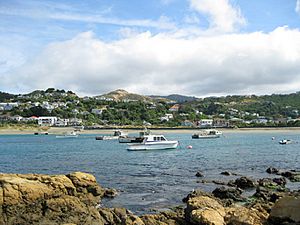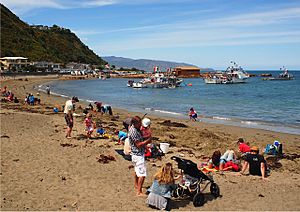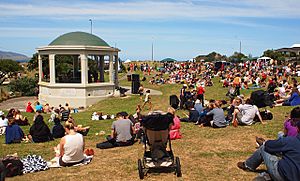Island Bay facts for kids
Quick facts for kids
Island Bay
|
|
|---|---|
|
Suburb
|
|
 |
|
| Country | New Zealand |
| Local authority | Wellington |
| Electoral ward |
|
| Established | 1879 |
| Area | |
| • Land | 215 ha (531 acre) |
| Population
(June 2023)
|
|
| • Total | 7,160 |
|
|
||
Island Bay is a coastal suburb in Wellington, the capital city of New Zealand. It's located about 5 kilometres (3 miles) south of the city centre.
The suburb gets its name from the bay it sits on. This bay is one of many small bays found off Cook Strait, which is the stretch of water between New Zealand's North and South Islands. About 500 metres (1,640 feet) from the shore in Island Bay is Tapu Te Ranga Island. This island acts like a natural wall, protecting the bay and making it a safe place for local fishing boats to anchor.
Some well-known people live or used to live in Island Bay. These include Andrew Little, a former Minister of Justice, and Celia Wade-Brown, a former Mayor of Wellington. Many artists, writers, and musicians have also called Island Bay home.
Contents
History of Island Bay
Tapu Te Ranga Island is an important place in Māori legends. It's believed to be the spot where the famous Māori chief Kupe first saw a giant octopus called Te Wheke-a-Muturangi. He then chased this octopus across Cook Strait.
Before Europeans arrived, Island Bay had several Māori settlements called pa. One of these was Te Mupunga Kainga, which is now remembered with a special carved pole, a pou, in Shorland Park. Different Māori tribes, known as iwi, lived in Island Bay over time, including Ngai Tara and Ngati Ira.
A famous battle happened on Island Bay beach. Warriors from the Ngai Tara tribe fought against a raiding taua (war party) from Muau-poko. Two Muau-poko chiefs were killed in this battle. Another pou now stands to remember this event.
In 1827, during a battle where Ngati Mutunga drove Ngati Ira from Wellington, the wife of the Ngati Ira chief, Tamairangi, found safety on Tapu Te Ranga Island with her children. She later escaped by canoe when the island was surrounded.
European Settlement and Growth
When Europeans first settled here, a man named George Hunter owned a large farm in Island Bay. He sold parts of it in 1879. In the late 1800s, fishermen from Italy and the Shetland Islands came to live in Island Bay.
In 1905, Wellington's tram line was extended to Island Bay. This made the area more popular and helped it grow into a seaside suburb. Many of the houses and shops you see in Island Bay today were built in the 1920s, a time when the area was developing quickly. There was even a racecourse in Island Bay back then! Many streets in Island Bay are named after rivers in Britain and Europe.
In 2016, a new cycle path was built along The Parade, which caused some discussion in the community.
Cool Places to See in Island Bay
Erskine College and Chapel
The beautiful Erskine College building was originally a Catholic girls' boarding school. It was built between 1904 and 1906. The nearby Erskine Chapel, built in 1930, has an amazing French Gothic style. It's considered one of the most beautiful chapels in New Zealand. The school closed in 1985, and the buildings are now privately owned. You might have seen Erskine College in the 1996 movie The Frighteners. The chapel is now a popular spot for weddings and concerts.
Island Bay Marine Education Centre
The Island Bay Marine Education Centre is right by the sea. It has a small aquarium and a special "touch tank" where you can gently feel some marine creatures. It's open to the public on Sundays and is a great place to learn about ocean life.
Churches in Island Bay
Island Bay has five churches. The oldest is the Anglican church, which is over 100 years old. It was recently updated to be safer in earthquakes. The church is named after St Hilda of Whitby, because the early settlers thought the coastline looked like Northumbria in England. There are also Baptist, Catholic, Serbian Orthodox, and Presbyterian churches. These churches often let community groups use their facilities.
Scuba Diving and Snorkeling Fun
If you love the ocean, Island Bay is a great place for you! Two diving companies here offer trips to the local Taputeranga Marine Reserve. You can also dive to the wreck of HMNZS Wellington, a former navy ship that was sunk on purpose in 2005 to create an artificial reef for marine life.
There's also a special snorkel trail on the eastern side of the bay. It's a fun way to see local fish and other marine creatures up close.
Shorland Park
Shorland Park is a public park right on Island Bay Beach. The playground was recently upgraded in 2021 and 2022, making it even more fun for kids.
The park also has a band rotunda, which is a round building where bands used to play music. It was built in 1930. Plaques on the rotunda remember the soldiers from Island Bay who died in World War I and World War II. In the past, brass bands and the Salvation Army often played here. Today, it's used for concerts, especially during the annual Island Bay Festival.
Tapu Te Ranga Marae
Tapu Te Ranga Marae was a special Māori meeting place located on a hill surrounded by native forest. It was built by Bruce Stewart between 1977 and 1983, using recycled materials. The main building was a huge wooden house with ten levels. Sadly, a big fire destroyed the marae on June 9, 2019.
Taputeranga Marine Reserve
The waters around Island Bay are protected as part of the 854-hectare Taputeranga Marine Reserve, created in 2006. This reserve is home to amazing underwater life, including kelp forests, octopuses, blue cod, and banded wrasse. You might even spot dolphins and whales visiting the area. The 200-metre snorkel trail mentioned earlier is part of this reserve.
Tapu Te Ranga Motu (the Island)
Tapu Te Ranga Motu, the island in the middle of the bay, was once a safe place for local Māori. Tamairanga, the wife of the Ngati Ira chief Whanake, found refuge on the island with her children during a battle.
Victoria University Coastal Ecology Laboratory
Victoria University of Wellington has a research lab in Island Bay called the Victoria University Coastal Ecology Laboratory. Scientists and students here study the amazing rocky reefs and marine life found along Wellington's south coast.
Walkways for Exploring
Island Bay is the starting point for two popular walking trails that cross the city. The City to Sea Walkway is 12 kilometres (7.5 miles) long and goes from Parliament to Island Bay, passing through the Botanic Gardens. The Southern Walkway is 11 kilometres (6.8 miles) long and follows the Town Belt between Island Bay and Oriental Bay.
Island Bay Festival
The Island Bay Festival is a fun event that happens every year for eight days in February. Here are some of the cool things that have been part of the festival:
- The Blessing of the Boats: This is a tradition from southern Italy where boats are decorated with flags and blessed by a priest. This is done to keep the crew safe at sea and bring them good luck. This ceremony has been held in Island Bay since 1933, after a fishing boat called Santina sank, and four crew members were lost.
- The Ribble Street Races: This is a soapbox derby where people race homemade cars down the steep Ribble Street. There are different categories for junior, intermediate, senior, and expert drivers. Some of the expert racers can reach speeds of 65 km/h (40 mph)!
- The Island Bay Raft Race: This race started in 2020. Families build their own rafts and paddle them parallel to the beach. The Lyall Bay Surf Club helps keep everyone safe during the race.
- The Swim to and from the Island: Brave participants are taken by boat to Tapu Te Ranga Island and then swim back to shore. There's also a race where people swim there and back!
- The Festival Parade: This colourful parade goes down The Parade street to Shorland Park. In the past, there was a fun competition where people decorated their bicycles.
- The Teddy Bears Picnic: On the last Sunday of the festival, younger kids bring their teddy bears for a picnic in Shorland Park.
Island Bay Community
Island Bay has an estimated population of about 6,897 people. It's a diverse community with people from many different backgrounds.
Arts and Culture in Island Bay
Island Bay is a hub for creative people!
- Rita Angus: A famous artist named Rita Angus painted many scenes of Island Bay when she lived in Wellington in the 1960s. Her painting Boats, Island Bay is very well-known.
- Empire Cinema: The Empire Theatre used to show movies from 1925 to 1964. It reopened as the Empire Cinema in 2005 and is a cool art deco building.
- Laura Garland: Artist Laura Garland lives in Island Bay and creates colourful paintings of Wellington and New Zealand.
- Michael McCormack: Michael McCormack is an Irish-born painter who used to work from his studio in Island Bay. He painted bright scenes of the streets and coast around Wellington.
- Music: Many musicians have connections to Island Bay. Andrew Fagan from the Mockers and Jon Toogood from Shihad grew up here. Samuel Flynn Scott and Conrad Wedde from The Phoenix Foundation also live in the suburb.
- Literature: Several children's authors, including Fleur Beale, Suzanne Main, and Brigid Feehan, all live in Island Bay.
- Red Mole: The experimental theatre group Red Mole, led by Alan Brunton and Sally Rodwell, was based in Island Bay for many years.
- Chris Visser-Fee: Comedian Chris Visser-Fee grew up in Island Bay and still lives there. He often performs funny routines.
- Freya Elkink: Artist Freya Elkink lives in Island Bay. Her art often uses an impressionist style to show popular Wellington faces in funny situations.
Schools in Island Bay
Island Bay has two schools for children:
- Island Bay School: This is a primary school for students from Year 1 to Year 6.
- St Francis De Sales School: This is a Catholic primary school for students from Year 1 to Year 8.
Images for kids













